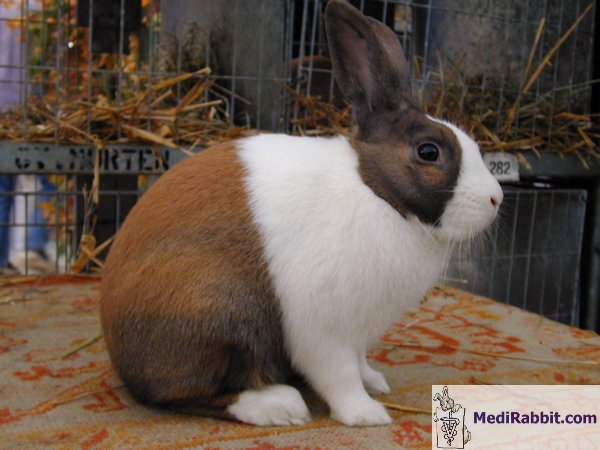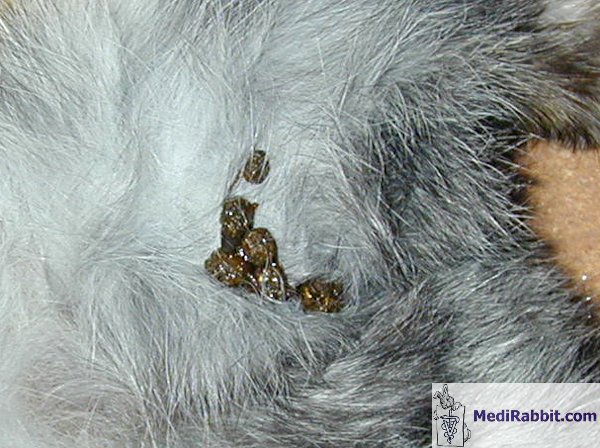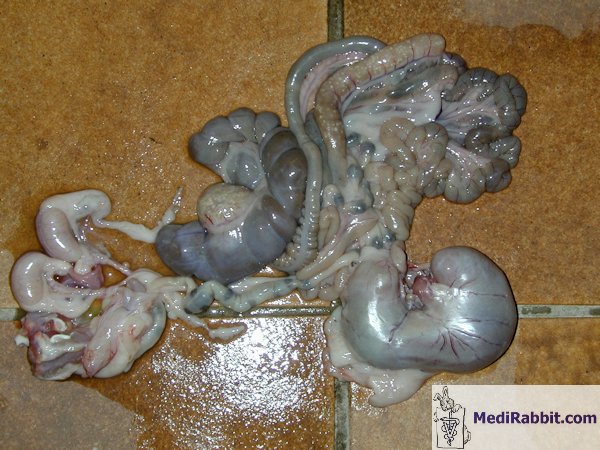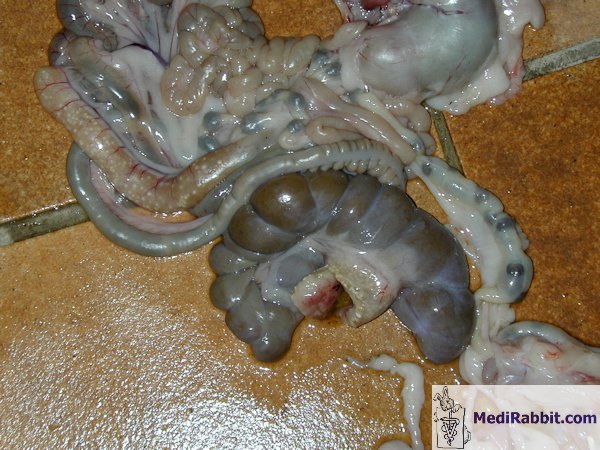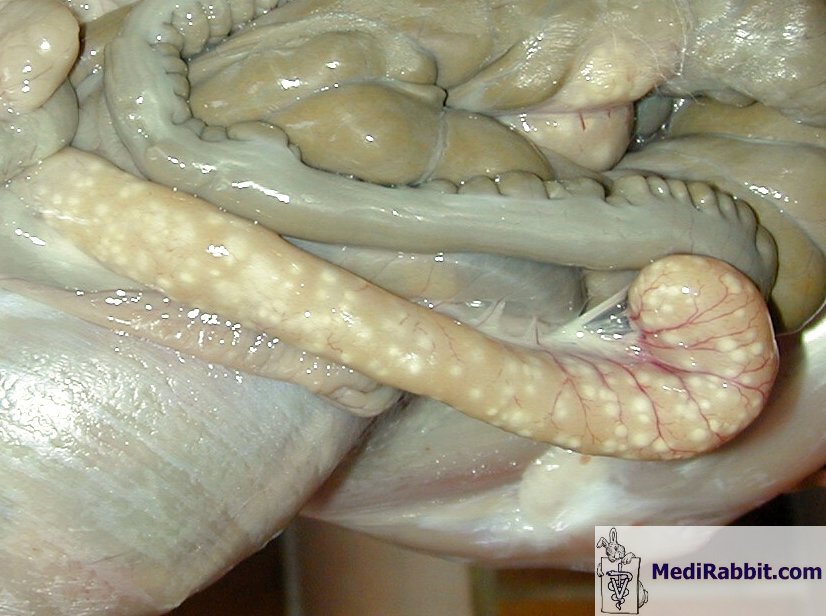Be careful, rabbit pseudotuberculosis
is transferable
disease that can be transmitted to humans
Michel Gruaz
(Article published in the animal
journal Tierwelt and graciously allowed to share
here in MediRabbit.com by M. Gruaz)
|
MediRabbit.com is funded solely by the generosity of
donors. Every donation, no matter what the
size, is appreciated and will aid in the continuing research of medical care
and health of rabbits.
Thank
you |
Warning: this page contains
pictures that may be distressing for some persons.
This sole and unique reason justifies
informing rabbit owners about this disease, which is rare but is observed
from time to time. It is important to recognize this as it is rather
atypical.
Over the course of
several years, I had three cases within a few months of each other. As a
result, the author of this article can report on the clinical signs of the
disease. This condition primarily affects adult animals or those that are
several years old. The rabbit's appetite diminishes progressively, and after
a few days, it will only consume small amounts of fresh food before
completely ceasing to eat. The droppings become progressively smaller,
harder, and stickier. The ventral abdomen is soft to the touch, and during
palpation, it is possible to feel that the contents of the abdominal cavity
decrease.
The animal rapidly
loses weight. In the absence of a decision to euthanize the animal, death
occurs within a few days. After presenting the pictures taken during the
necropsy to one veterinarian, the images were subsequently reviewed by Dr.
med. vet. Richard K. Hoop of the Institute of Veterinary Bacteriology at the
University of Zurich (Switzerland) diagnosed the condition as
pseudotuberculosis. These experts cautioned the author about the potential
risks of transference to humans and advised against touching one's mouth
after handling a sick rabbit. It is important to note that no additional
cases have been observed among the rabbit population under the author's care.
According to Boucher et Nouaille the disease is rare
in rabbits
Yersiniosis or pseudotuberculosis is a rare disease in rabbit
husbandry. It does, however, infect birds, such as the common wood pigeon, as
well as on rodents, including guinea pigs. When there is contact between the
latter and rabbits, there is a risk of infection. The disease has been
observed in farm rabbits living in hutches and in pet rabbits living in the
vicinity of birds infected by the bacterium. Wild rabbits and hares can be a
source of infection as well. Hares are highly susceptible to yersiniosis. In
this species, the disease is frequently observed. It is the primary cause of
mortality in certain regions of France and Germany. The disease is considered
zoonotic, meaning it can be transmitted to humans. This disease primarily
impacts boys between the ages of 8 and 13. The signs are similar to those of
appendicitis. These symptoms may be accompanied by skin inflammation and
redness. It is important to note that both humans and animals can be affected
by either a generalized infection and severe septicemia, or by localized
infections in the lungs or eyes. The septicemic form is fatal within 24 to 48
hours, while the chronic form may become fatal after 2 or 3 months, although
many survivors have been documented.
A bacterium called Yersinia
is causing the disease
This
infection is caused by Yersinia pseudotuberculosis, a bacterium that was
discovered in 1883 on a guinea pig inoculated with the nodule of a child who
died of tuberculous meningitis. It is a small, cosmopolitan, Gram-negative
bacterium that is rod-shaped. This bacillus or bacterium is present in
infected or healthy animal and human individuals. Birds and rodents primarily
serve as the reservoir for this disease. However, it is important to note
that this bacterium can also be found in various environmental sources,
including soil, water, and food contaminated with the excreta of infected
animals. In rabbits, the bacterium has been observed in fecal samples as well
as in cecal droppings. It has the capacity to survive in the soil for over a
year. It is capable of multiplication at temperatures ranging from 4 to 10°C.
This ability may be linked to the rise of infected rabbits during the winter
season. The soil is the primary source of contamination. Therefore,
particular care should be exercised when burying a dead rabbit. Caution
should be taken when applying manure to the soil. It is imperative to ensure
that bodies are not decaying in a pile of manure. This bacterium can spread
back into the soil in this manner.
After ingestion, the bacterium reaches the intestine, where it begins
to multiply. At 37°C, the bacterial population will grow rapidly, and
bacteria will begin to invade the lymphatic nodules associated with this
organ. In the septicemic form of the disease, the rabbit will die rapidly and
without noticeable clinical signs. In the non-septicemic forms, the rabbit
exhibits signs of fatigue, including emaciation and exhaustion. It may also
experience diarrhea. During palpation, the nodules exhibit signs of hypertrophy.
The liver displays a pattern of fairly hard nodules. The intestine may
exhibit necrotic regions. In some cases, the kidneys and lungs are affected.
It is important to note that not all animals die.
Suspicion, onset and passing over of
the disease
Necropsy results may provide useful diagnostic insights. Hypertrophy
of the lymphatic nodules is observed, and the spleen is twice to three times
larger than normal. The kidneys, spleen, and intestines display minor
white/yellowish nodules on their surface. These nodules bear a resemblance to
those observed in cases of tuberculosis, hence the term
"pseudotuberculosis." A bacteriological examination of the affected
organs (kidney, spleen, liver, intestine, bone marrow) is the sole diagnostic
tool that can provide a conclusive diagnosis of the disease. It is essential
for rabbit owners who also have birds, hamsters, guinea pigs, or poultry in
the same barn to educate themselves on fundamental hygiene practices. The
feeding of grains left over by birds living in hutches to poultry is a
well-known source of contamination by Yersinia bacteria in the barnyard. It
is also important to look for possible contamination of the soil and plants.
Contamination is frequently of an oral and digestive nature.
The incubation period is long, with an average duration of 15 days.
The bacteria then reach the lymphatic system, and nodules appear on different
organs. Following the ganglionic stage, the liver is invaded and becomes the
starting point for septicemia.
Prevention is always more desirable
than treatment
It is recommended that hutches, pens, and the living environment of
the rabbit be disinfected, as well as the soil. Walls can be thoroughly
cleaned. The water should be treated with an antibacterial product to kill
the bacterium before it is discarded. Accessories or hay must be burned.
These objects can be soaked in a bactericidal solution, which can be found in
drugstores, for at least an hour. The drinking water of the rabbits is
treated with a disinfectant that is based on chlorine. Simultaneously addressing
the issue of rodents is essential. It is also imperative to meticulously
inspect other breeding sites. It is recommended that prophylactic measures be
taken. The treatment itself includes the administration of enrofloxacin (Baytril), 15 mg/kilo fresh weight, for a period of 8
days. Following a 10-day cessation of treatment, a second antibiotic regimen
is administered for an additional 8 days. A bacteriological study, also known
as an antibiogram, is a methodical analysis that evaluates the sensitivity of
bacteria to various antibiotics. This study plays a crucial role in
determining the efficacy of other molecules.
More Information
Maladies des
lapins de Boucher et Nouaille
Textbook of Rabbit Medicine, Frances
Harcourt-Brown, Oxford,
The Biology of the Laboratory Rabbit, Patrick J.
Manning, Daniel H. Ringler and Christian E. Newcomer,
Vetstream,
https://www.vetstream.com/lapis/Content/Freeform/fre00324.asp
Zoonoses and Communicable Diseases Common to Man
and Animals: Bacterioses and Mycoses v. 1 - PAHO
Scientific Publications S. No. 580, Pedro N. Acha,
Boris Szyfres.
|
|||||||||
e-mail: info@medirabbit.com



